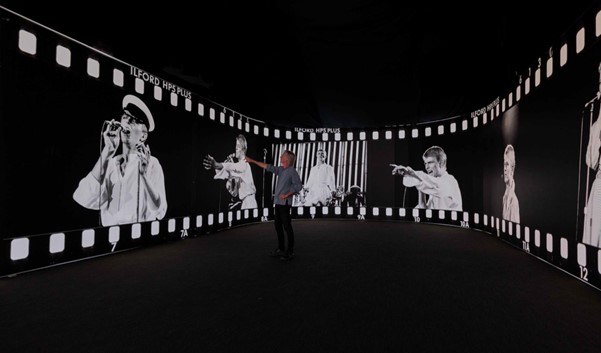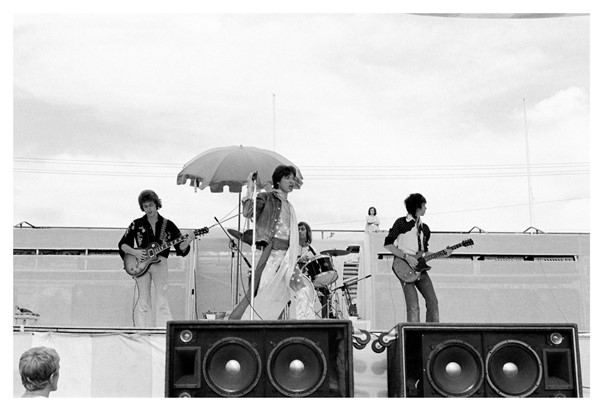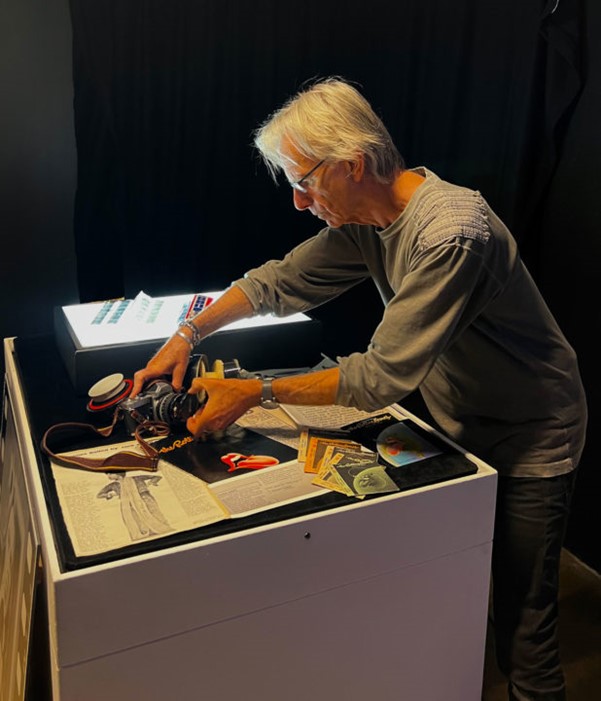
Scott Hicks in front of his photos of David Bowie in 'Behind the Velvet Rope' at Light Adl – 'I just love his gesture, he’s quite powerful.' Photo: Oscar Lewis
He’s the Hollywood-feted director who earned two Oscar nominations for his critically acclaimed biopic Shine. But during the 1970s, long before he got to rub shoulders with Steve Martin and Billy Crystal at the Academy Awards, Adelaide filmmaker Scott Hicks was studying an arts degree at Flinders University.
In his downtime, Hicks had an enviable hobby. Armed with an automatic Nikkormat camera, he could be found front and centre when international acts came to Australia to perform.
Hicks sweated through a Rolling Stones concert at Kooyong Tennis Club in 1973 and got soaked to the skin watching David Bowie play saxophone in the rain at Adelaide Oval in 1978.
He snapped Bob Marley at the old Apollo Stadium, Bob Dylan in West Lakes in 1978, David Cassidy’s 1974 tour, and Sting with the Police. All, largely, for fun.
“You felt connected to the culture and the concerts made you a part of it,” Hicks tells InReview after a Saturday morning bike ride.
“In those days, I mean, all you got was Rolling Stone magazine a month late and your access to information was so limited but popular culture ideas seemed to filter very quickly through.
“It was an event when Bowie came to town – it was massive. It was the first time he had performed in the Southern Hemisphere and I saw him fleetingly at Flash Gelati on Hindley Street and remember thinking, ‘That’s David Bowie buying a gelati’.”

One of Scott Hicks’ photos of The Rolling Stones during their 1973 tour.
Hicks’ collection of electric and haunting black-and-white film photography from these concerts and more will go on display in Behind the Velvet Rope at Light ADL from this Saturday.
His film photographs have been enlarged and will be projected across 50sqm of LED screens for the exhibition. Behind the Velvet Rope plays on a 30-minute loop, including a film of Hicks talking about the images and how he captured them.
Light ADL co-founder Nick Dunstone approached the photographer and film director last year about showing the images on a “gigantic scale”. Hicks, who presented a solo exhibition of candid photos of fellow creatives at BMG Art last year, was intrigued by the offer.
“Seeing these images through this huge, immersive screen has, in a way, taken me back to the experience of being at the concerts,” he says.
Asked about his best work, Hicks flips open his phone case. He pinches the PDF saved on his phone, enlarging a 35mm strip of film with three photos from 1978.
Across four frames, Bowie cuts a ghostly yet angelic figure performing at Adelaide Oval in 1978. Hicks says they are his “hero shots” because they perfectly demonstrate the late artist’s power and theatricality.
“I just love his gesture, he’s quite powerful.
“It was a stupendous show – by today’s standards probably very basic, but for then, it was incredibly sophisticated with light shows, multiple costume changes and all sorts of theatrical stuff which made it heaven to shoot.
“I had a challenge, which was shooting celluloid, because you have to make choices, not like today where you can shoot one thousand frames and pick the best one.
“Then, you had to make choices, really distinctly because it’s all manual focus and manual exposure and the difference was you knew when you got it.
“I saw those moments and when I got home I was looking for that frame when I was developing the negative, drying the negative with a hairdryer and finding it.”
Hicks, who moved to Adelaide from the UK at 14, says getting close to the stage required “sheer bravado”.
The first concert he photographed was the Rolling Stones in Melbourne. He, wife Kerry Heysen and son Scott were “complete groupies”. They saw five Stones concerts in under a week, following the band from Melbourne to Adelaide.
“We smuggled our infant son Scott in under our jacket and I apologised to Mick Jagger decades later when we met,” he says, laughing.

Hicks with his camera and items from The Rolling Stones’ tour.
“He wanted me to do a movie for his film company and I said, ‘I have a little confession to make: I owe you a ticket from 1973’. And I explained and he said, ‘Oh, don’t worry about it’.
“That was almost 50 years ago. I can’t believe it.”
Hicks, 69, refers to artists such as Jagger as “wonderful fossils in a very rich sedimentary layer of our cultural palaeontology”.
“It stops me in my own tracks to look back and think I’m now as distant from those events as at the time, I would have been distant from Rudy Valentino or Al Jolson,” he says reflectively.
“That’s so strange because the Rolling Stones are still performing, whereas in my day, Al Jolson never left the 1930s as a phenomenon. That’s why I refer to these people as [giants] of pop culture because they are so enormous. I mean, The Motels are still going – I have a shot of them in there.
“It really forces you into that kind of reflection, and that age is a strange construct because part of you hasn’t grown old and I’m just as invigorated by that past as I am by the present in some respect.”
Scott Hicks – Behind the Velvet Rope runs now to 14 May at Light ADL. The exhibition is open to the public Wednesday to Saturday from 6pm to 9pm. Cost of entry is a $10 donation at the door, which goes to support the Light Cultural Foundation.
By Kurtis Eichler


